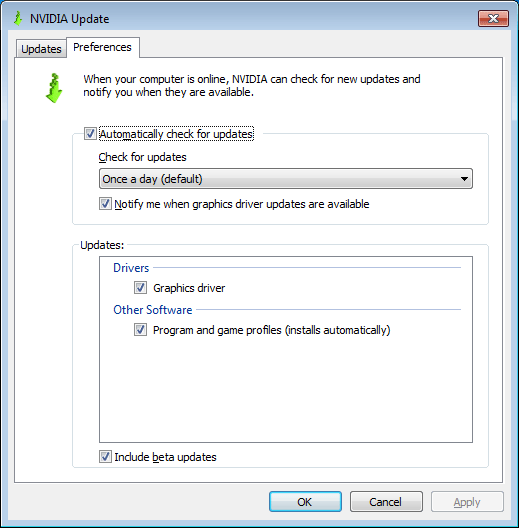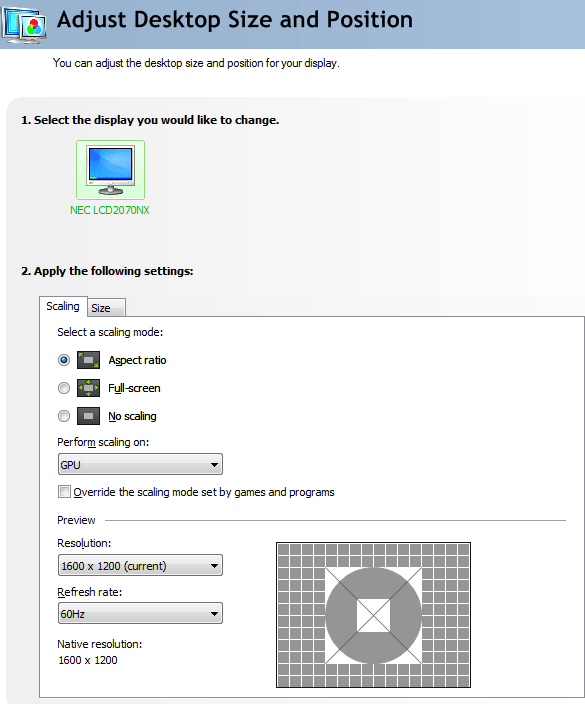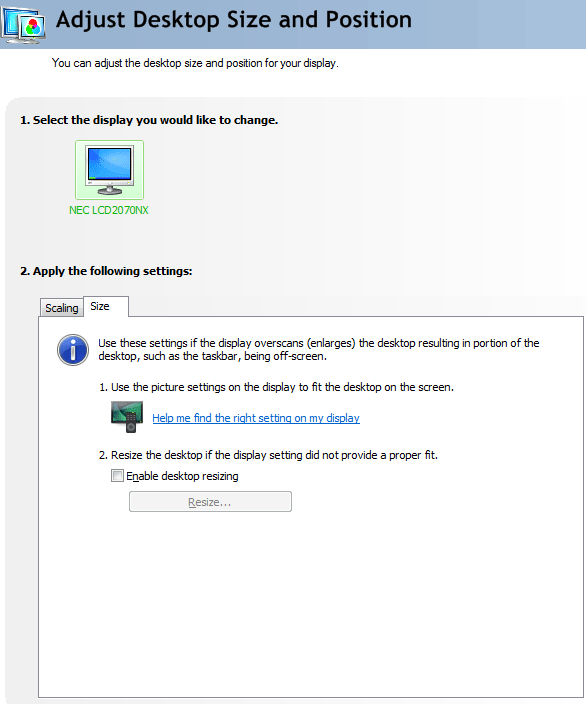NVIDIA's GeForce GTX 560: The Top To Bottom Factory Overclock
by Ryan Smith on May 17, 2011 9:00 AM ESTNew Release 275 Drivers & The Test
Launching alongside the GTX 560 will be the newest branch of NVIDIA’s GeForce drivers: Release 275 beta. This actually comes hot on the heels of Release 270, which came out only a month and a half ago.
Unlike Release 270 NVIDIA isn’t making a lot of performance promises, so this is mostly a feature release. The big item in 275 for most gamers will be further refinements to the auto-update mechanism first introduced in 270. NVIDIA has finally fully ported over Optimus’ auto-update feature, meaning that NVIDIA’s drivers can now automatically find and install profile updates in the background. However whereas Optimus profile updates were necessary for switchable graphics, for desktop users the primary purpose of auto-updating profiles is for SLI and anti-aliasing compatibility, as NVIDIA uses compatibility flags in their profiles to make those features work.

Automatic profile updates won’t completely absolve SLI from periods of incompatibility, but it should help. NVIDIA has released out of band profile updates for SLI before, but these were rather rare. If they now release profile updates much more frequently, then this will be a boon for SLI users, particularly GTX 295/590 users. Otherwise SLI is mostly limited by what can be done with a profile – if NVIDIA has to update the driver itself, then users will still need to wait for a new driver release. Which on that note, NVIDIA hasn’t changed the auto-update procedure for the drivers: profiles will auto-download and install, but driver updates must still be manually approved.
NVIDIA tells us that in the future they will also be able to deliver 3D Vision compatibility updates with profiles, but this will probably require a bit of a rearchitecting to their drivers and profiles. Currently NVIDIA’s profiles contain a few flags for 3D Vision (mainly whether it’s allowed), but there aren’t any sweeping compatibility bits as there are for SLI and AA.
Moving on, the other big functionality update with 275 is a new resizing and scaling UI in the NVIDIA control panel. The core functionality of scaling hasn’t changed much as NVIDIA has offered these controls for quite some time, but now scaling controls are available for VGA and HDMI displays, versus just DVI and DisplayPort as it was previously. There’s also a new override option or Windows 7, for forcing misbehaving programs to use NVIDIA’s scaling options instead of their own. (Ed: We’ve never actually encountered this before. If you know of any games/applications that need this option, please let us known in the comments)

As for resizing, NVIDIA has tweaked the UI to help better guide users through using overscan correction and/or disabling overscan on their TVs. The ideal method of dealing with overscan is to disable it on the TV (thereby ensuring 1:1 pixel mapping), which is what NVIDIA now first directs users toward. For users that can’t disable overscan, they can then unlock NVIDIA’s resizing controls. NVIDIA tells us that they’ve also done some work to improve resizing compatibility for games/applications that try to force standard resolutions, but we have not had an opportunity to test this yet.

The Release 275 betas should be available later today, with WHQL drivers appearing within a month.
The Test
As we mentioned in our introduction, the lack of any reference-clocked cards means that the GTX 560’s clocks – and thereby the GTX 560’s performance – is not well rooted. As a result we’ve tested our ASUS GTX 560 DirectCU II Top at a few different clockspeeds. We’ve tested the card at NVIDIA’s reference clocks of 810/4004 (GTX 560 Base), along with the slowest "mid-grade" card on NVIDIA’s release list: 850/4104 (GTX 560 Mid). NVIDIA is pitching the GTX 560 as their $199 card, so for the purposes of our review we’ll be focusing primarily on the mid-clocked GTX 560, as this is the approximate speed of most of the $199 cards. If you buy a $199 GTX 560 today, this should closely represent the speed of the card you’re buying.
Ideally 810/4004 cards will be relegated to the OEM market, but if not we also have the base clocks included for appropriate consideration. It goes without saying that we’d rather NVIDIA just create two different product lines rather than having so many cards under the same umbrella, but at this point we’re just repeating ourselves.
We’ve also included our overclocking results with the ASUS GTX 560 DirectCU II Top, colored in orange. As we were only able to reach 950/4400, the performance gains are limited.
For drivers, on the NVIDIA side we’re using 275.20 beta for the GTX 560, the GTX 460 1GB, and GTX 560 Ti. In practice the average performance difference between release 275 and release 270 is around 1% in favor of 275. On the ATI side we’re using the Catalyst 11.5a hotfix; however do note that in our testing we’ve found that performance is identical to the 11.4 drivers.
| CPU: | Intel Core i7-920 @ 3.33GHz |
| Motherboard: | ASUS Rampage II Extreme (X58) |
| Chipset Drivers: | Intel 9.1.1.1015 (Intel) |
| Hard Disk: | OCZ Summit (120GB) |
| Memory: | Patriot Viper DDR3-1333 three x 2GB (7-7-7-20) |
| Video Cards: |
AMD Radeon HD 6970 AMD Radeon HD 6950 2GB AMD Radeon HD 6870 AMD Radeon HD 6850 AMD Radeon HD 5870 AMD Radeon HD 5850 AMD Radeon HD 5770 AMD Radeon HD 4870 NVIDIA GeForce GTX 580 NVIDIA GeForce GTX 570 NVIDIA GeForce GTX 560 Ti ASUS GeForce GTX DirectCU II Top NVIDIA GeForce GTX 550 Ti NVIDIA GeForce GTX 480 NVIDIA GeForce GTX 470 NVIDIA GeForce GTX 460 1GB NVIDIA GeForce GTS 450 NVIDIA GeForce GTX 285 NVIDIA GeForce GTX 260 Core 216 |
| Video Drivers: |
NVIDIA ForceWare 262.99 NVIDIA ForceWare 270.51 Beta NVIDIA ForceWare 275.20 Beta AMD Catalyst 10.10e AMD Catalyst 11.4 AMD Catalyst 11.5a |
| OS: | Windows 7 Ultimate 64-bit |










66 Comments
View All Comments
Ryan Smith - Tuesday, May 17, 2011 - link
We always include MIRs in our pricing, given their prevalence. With MIRs, there are no fewer than 6 6870s at Newegg below $180 (and a 7th at $183).C'DaleRider - Wednesday, May 18, 2011 - link
"I don't know where you guys are getting this information, but the Radeon HD 6870 IS NOT at $180."Actually, I don't know where YOU are getting your misinformed information.
Right now, on Newegg, 6870's are as low as $162 after rebate, $182 before rebate. (An XFX card, btw.)
Take a look......
http://www.newegg.com/Product/ProductList.aspx?Sub...
Now, maybe you'll get your facts correct before posting drivel.
L. - Thursday, May 19, 2011 - link
Don't feed teh trollz ;)Stas - Wednesday, May 18, 2011 - link
Idk, I paid $160 for my Sapphire HD6870 with dual fans 2 months ago o.Oaraczynski - Tuesday, May 17, 2011 - link
...would those 'in the know' know whether games like the witcher2 and skyrim would be better off with the nvidia or amd line?TheJian - Wednesday, May 18, 2011 - link
Witcher 2 doesn't use Aurora engine, all new now so wait for it to be put in some sites benchmarking. Same with skyrim, it uses a new Creation engine, and also 100% dynamic lighting with lots of snow and cliffs (which this engine is designed for).Sorry. Not much worth extrapolating other than we have no idea who will win later :) If we're being honest anyway. I suppose a quick google might get a hit on the devs opinions.
Sunsmasher - Tuesday, May 17, 2011 - link
Your comments about confusing naming are very valid.I've long ago come to the conclusion that the confusing naming issue is a deliberate strategy by Nvidia.
They WANT to create confusion to make it more difficult for less sophisticated buyers
to compare cards head to head and Nvidia can thereby pick up a few more sales than they would otherwise.
The proof that this is deliberate is the fact that they Keep Doing It.
Otherwise, they would have very straightforward, very easily compared naming conventions:
Higher numbers = more power, GT not as powerful as GTX, etc.
An unfortunate state of affairs, but not about to change even with writers often complaining about it.
Fortunately, there are resources on the web that compare cards head to head.
TheJian - Wednesday, May 18, 2011 - link
They're not trying to confuse you. They're just trying to sell every chip they can. A lot of dies have defects etc that cause them to release a plethora of cards at different speeds, features disabled (possibly due to defects in dies) etc. Die shrinks cause problems too. Sometimes they save enough in power/heat to warrant a new release # or model. Take the GTX 260. The core216 came out, fixed heat issues and was a good 10% faster. People would want to identify the faster/cooler cards and not get screwed. I hate Motherboard makers not listing the REV prominently on the box, or in ads. It's tough to buy online when I'm after a specific rev. This is more a tech issue than a company deliberately ticking us off.If you don't mind paying MUCH higher prices, they can go ahead an toss all defective dies and get back to 3 product lines with easily seen performance advantages between the 3. AMD, Intel, Nvidia, etc they all have this problem. Of course progress would really slow down if they take this route. A person going into the store and seeing a 6750 card, might find a 5850 sitting next to it for $200 and wonder what the heck is going on...LOL. I could almost say the same about the 6850. That 6850 should blow away a 5850, I mean its a whole 1000 higher right? Confusing yes? But that 5850 beats the 6850 by about 10% in everything. There are a lot of these examples. Heck this time NV let the manufacturers decide everything (clock/memory/ref design).
In an age of small margins, just about everything in your PC being a commodity, and shareholders demanding every last dollar they can get from company X, you should just get used to tons of products not performing too differently. Really, I can make up my mind in one night of reading reviews on 3-4 websites. By the end of the night I can decide how to spend my money and be fairly certain I'm not making a big mistake. But yeah, if you're not willing to do some homework, get ready to buy something that's completely disappointing on occasion. But you're already here, no worries :) We have hardware review sites, because stores shelves and floor reps at fry's don't help us at all... :) I pity marketing dept's trying to work with all these dies/re-launches/binning etc that probably cause them nightmares...LOL Could they do better here and there? Probably. Would I like to try to make us all happy? HECK NO. :) I take that back, I wouldn't mind taking a crack at intel naming. :)
sysdawg - Tuesday, May 17, 2011 - link
Ryan,Thanks for your reviews. On page 3 you write "on the ATI side we’re using the Catalyst 11.5a hotfix"...but is that the case for all the AMD cards? The same page lists three drivers being used: Catalyst 10.10e, 11.4, and 11.5a. And for the Nvidia cards, you also list three drivers: 262.99, 270.51 beta, and 275.20 beta. If you could help, I'd specifically like to know which drivers were used for the GTX 580 and the Radeon 6970. And since I'm going to be running at 2560x1600, it would also help to know which drivers were used for those 2 cards in your March 24 review (of the GTX 590), since that review included that resolution. My thinking is that if the drivers are reasonably current for both cards, then it is closer to being 'apples to apples'.
Thanks in advance, and thank you again for your reviews.
Ryan Smith - Wednesday, May 18, 2011 - link
Cat 10.10e: Radeon 3xxx/4xxx.Cat 11.4: Radeon 5xxx/6850/6970
Cat 11.5: Radeon 6870/6950
262.99: GeForce 2xx
270.51: GeForce 4xx, 580/570/550
275.20: GeForce GTX 560 Ti, GTX 460, GTX 560
As for the March 24th review of the GTX 590, all the high end cards were on 266/267 drivers or the Catalyst 10.4 preview drivers respectively. Those were the newest drivers at the time of that publication.
And I apologize for the somewhat chaotic nature of the driver selection. We benchmark many different cards, redoing them for every single driver revision simply isn't practical. The relevant cards will be updated for any given article, and many (if not all) of the cards are updated if there's a major driver release that significantly impacts performance.